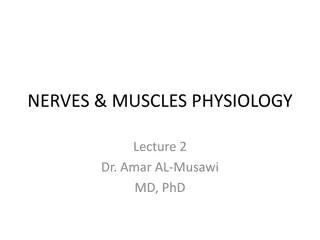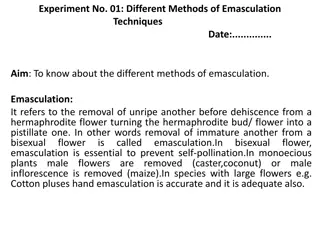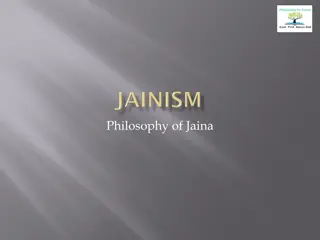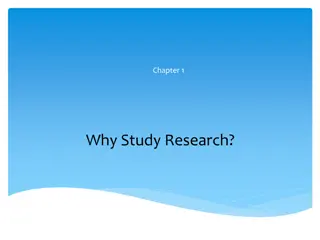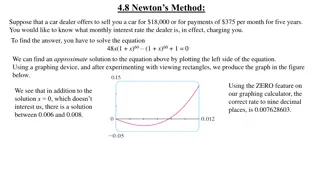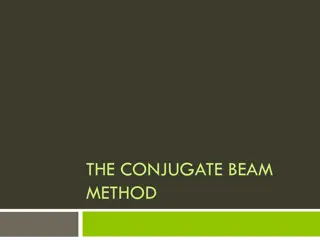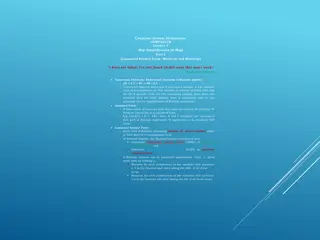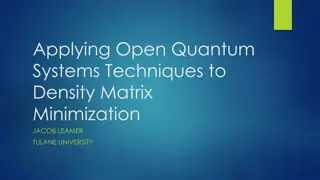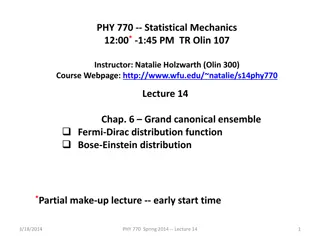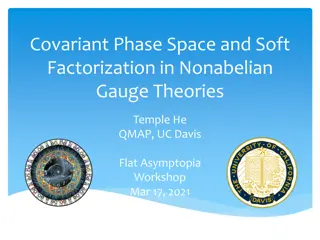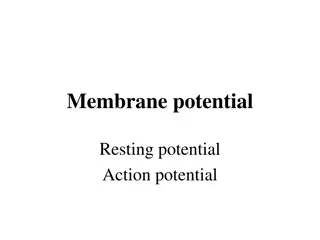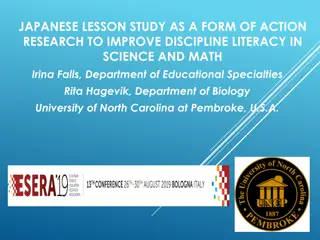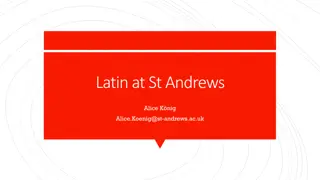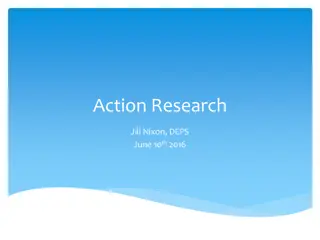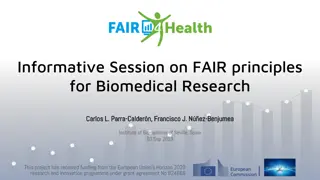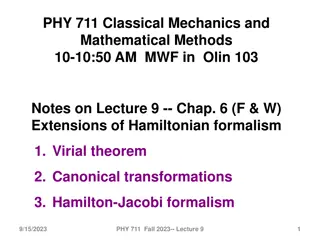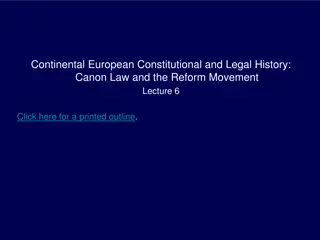Understanding Canonical Action Research: Method, Principles, and Practice
Canonical Action Research involves researcher intervention to address organizational problems, contributing to both academic theory and practical solutions. It emphasizes the importance of engaging with interpretivist epistemology, iterative and rigorous processes, and collaborative efforts between researchers and clients in a flexible and adaptive manner.
- Action Research
- Organizational Problems
- Research Methodology
- Interpretivist Epistemology
- Collaborative Approach
Download Presentation

Please find below an Image/Link to download the presentation.
The content on the website is provided AS IS for your information and personal use only. It may not be sold, licensed, or shared on other websites without obtaining consent from the author. Download presentation by click this link. If you encounter any issues during the download, it is possible that the publisher has removed the file from their server.
E N D
Presentation Transcript
Canonical Action Research: Method, Principles and an Illustration Robert M Davison Dept of Information Systems City University of Hong Kong
Introduction Action Research involves solving organizational problems improving organizational (employees, managers, customers) by means of researcher intervention, thus contributing to knowledge about both academic theory & organizational practice circumstances for stakeholders 2
Two Demanding Masters Client Need for organizational problem solving Research Community Need for knowledge that is relevant in this organizational situation and is also applicable to other problem contexts (in other organizations) 3
Epistemology Canonical AR is usually premised on an *interpretivist* epistemology The CAR researcher-practitioner needs to engage in many interpretive and diagnostic acts, thinking carefully about the organizational situation, representing the world as experienced by the clients. Disciplined subjectivity and imagination are critical skills 4
Canonical AR is Iterative - with one or more cycles of interventions Rigorous - correct use of methods in the task context Carefully planned iterations to develop detailed problem context knowledge and to identify relevant solutions Continuous problem (re)diagnosis Flexible application of the method Collaborative Researchers and Clients must work together Clients must actively participate in the project 5
Canonical AR Projects A CAR project can be expected to investigate the evolution of an organizational change process in great detail Each organizational context will have a unique set of constraints and idiosyncracies Organizational circumstances are ever changing So you can t plan everything in advance There is an infinite variety of circumstances that you will have to be prepared to adapt to! Can be structured according to principles and criteria, but these need to be applied sensitively 6
Principles & Criteria 1. Researcher-Client Agreement 2. Cyclical Process Model 3. Role of Theory 4. Change through Action 5. Specification of Learning 6. Ethics 7
1. Researcher-Client Agreement Guiding foundation for the project Client must understand what CAR involves Mutual guarantees for behaviour Basis for building trust in the organizational context Promote a spirit of shared inquiry 8
2. Cyclical Process Model Sequential progress through the Cyclical Process Model helps to ensure rigour Some between-stage iteration may occur needs to be justified Usually several cycles are necessary 9
CAR Cyclical Process Model Project Start Project End Diagnosis ActionPlanning Reflection Instrumental Theory Focal Theories Researcher-Client Agreement Evaluation Intervention 10
3. Theory Theory is a central component of Action Research Theory can help the consultant to analyse a situation, to ask the right questions and then to plan the changes Lewin (1945): There is nothing so practical as a good theory . Ghoshal (2005): Nothing is as dangerous as a bad theory . 11
3. Theory Action Research without theory - is not research McKay & Marshall (2001) It is highly unlikely that the researcher can know definitely and in advance the exact theory that will be used or developed Cunningham (1993) Premature application of theory may be counterproductive So theory-free problem diagnosis may need to precede CAR, yet theory is important Two types of theory: instrumental and focal 12
Instrumental Theory Instrumental theories Help us to organize our thoughts, generate coherent explanations [and so] achieve understanding (Hambrick, 2007). Will be practical (Lewin 1945) and closely match reality (cf. Weick 1995). Instrumental theories are particularly valuable for diagnosis and planning They play a mediating role between client and researcher They are used to explain and analyse organisational activities related to the project/problem They include any tools, models or processes that help us to make sense of how work is done or how outcomes are achieved. 13
Examples of Instrumental Theories Balanced Scorecard Value Shop, Value Chain, Business Process Models Porter s Five Forces Analysis SWOT and PEST Work Systems Theory Any model or theory that can be applied to an organisational situation so as to make sense of what people do 14
Focal Theory Provides the intellectual basis for action-oriented change in an AR project. Is unlikely to remedy an organisational problem alone; must be in combination with one or more instrumental theories Must be aligned to the precise organisational circumstances Good examples of general purpose focal theories are: Theory of Planned Behaviour Technology Adoption Model Punctuated Equilibrium Theory Transactive Memory Theory 15
PET: Punctuated Equilibrium Theory Unlike theories of steady but slow incremental change, PET suggests that change takes place in revolutionary bursts, triggered by significant environmental changes that break apart a system s deep structures Technological innovation can be one such environmental change, e.g. AI, Blockchain, etc. 16
TMT: Transactive Memory Theory Individual people can serve as external memory aids to each other (Wegner, 1986) Members of a Transactive Memory (TM) System (TMS) can benefit from each other s knowledge and expertise if they develop a good, shared understanding (meta-memory) of who knows what. TMS enable better use of knowledge held by members and so higher performance 17
Theory & Consequences A theory must be selected because it fits the organizational circumstances, the IT, the people, the culture. The client needs to understand the theory and its implications for change before approving it formally. An inappropriate theory could push the organization to change in a direction inconsistent with its organizational culture, leading to internal conflicts, or worse. 18
4. Change through Action Action and change are indivisible If there is no change No problem, intervention failed, or obstacles prevent successful intervention Both researcher and client must be motivated to design and implement change The change needs to be contextually and culturally appropriate (cf. theory) 19
5. Learning through Reflection Both masters need to learn from the researcher s reflections Practical solutions for the client Knowledge for the broader scholarly community Speceific knowledge for the Action Research community 20
6. Ethical Considerations for Action Research Avison et al. (1999, p.94), observed that action research combines theory and practice (and researchers and practitioners) through change and reflection in an immediate problematic situation within a mutually acceptable ethical framework . McKay and Marshall (2001, p.55) also emphasise that the researcher is ethically bound to try to alleviate the problem . Shah et al. (2007a, p.764) note that they drew up a formal research agreement to define the ethical guidelines yet provide no details about its content Myers and Venable (2014, p.802) suggest that there is a need to initiate a dialog and debate about the need for ethical principles .
Ethics and Stakeholders Apart from the action researchers, AR involves clients These may be managers, employees, customers, supply chain partners, third party service providers, etc. Arguably, each has a more-or-less participative role to play AR is often premised on collaborative acts between researcher and client the researcher and client work together in planning and implementing change in order to ameliorate a problem situation, and thereby improve circumstances for a variety of stakeholders But getting them to participate is far from simple Also, the researcher has to get prepared in order to participate effectively
Ethical Perspectives Chatterjee and Sarker (2014) identify consequentialism, deontology and virtue as three major ethical perspectives. Consequentialist ethics usually focus on the generation of positive outcomes for the stakeholders whose interests are central to the topic of enquiry. Deontological ethics are associated with duties. These often involve respecting the rights of individuals, so long as the rights of others are not impinged upon. Virtue ethics relate to the character of the individual actor and the assertion that good people (or institutions) will do good things. For instance, Kohli and Kettinger (2004) suggest that patience and flexibility are two of the desired virtues for action researchers. 23
Ethical Dilemmas (after Rapoport, 1970) Role dilemma action researchers play two roles: researcher and consultant, and thus serve two masters What promises should the action researcher make, given the need to improve organizational circumstances and achieve research objectives? Value dilemma the differences in values between researchers and clients Clients likely want quick and decisive action, but researchers tend to work more slowly, methodically in the pursuit of knowledge Goal dilemma the difference between the practical problem and the research problem The interests of the client and researcher are not perfectly aligned
For Instance Mumford (2001, p. 15) reported how she was always able to avoid working on projects where she disagreed with the ethics of the organization. For instance, she always refused to work on projects which would involve employee redundancy , reflecting a deontological stance. Researchers with a more critical interest may have an emancipatory goal for employees, aiming to ameliorate circumstances for them. 25
Ethics, and Theoretical Contributions A consequentialist view would be that the researcher has an ethical obligation to create a positive outcome for the organisation, only suggesting actions that improve the problem situation (Baskerville and Wood-Harper, 1996, 1998), even though this may constrain the researcher from reaching theoretically interesting conclusions. Both Lewin (1945) and Ghoshal (1996) observed that theories must be appropriate for the organizational context. Scholars who venture into the organizational arena with theory-in-hand beware! If, by dint of your academic enthusiasm, you neglect the interests of the organization and foist on them a damaging process or solution based on a theory that is of intellectual interest to you, then watch out. In more litigious societies, professional indemnity insurance may be advisable. 26
Ethics and Participation in AR The ethics of collaboration Researchers and clients work together collaboratively The ethics of competence researchers must be knowledgeable about the context, the industry, the nature of work in the client s world and then engage in meaningful conversations with clients as they diagnose problems and plan interventions The ethics of persistence It can take years to complete an AR project The ethics of consent and anonymity Protecting identities and the right to opt out 27
Illustrating the CAR Process From 2014-2016, I worked with Louie Wong, my PhD student, on an extended study of knowledge sharing in Velox, a global logistics firm I will draw on this experience to demonstrate the impact of CAR in practice in the next group of slides Knowledge Sharing in a Global Logistics Provider: An Action Research Project 28
Introduction Knowledge sharing is important for firms in today s competitive business environment Some resource-rich firms provide abundant IS-based work systems to their employees Our focus is the global logistics sector DHL, Fedex, UPS, TNT, SF Express, etc. 29
Velox We have been working with Velox, a global courier and delivery services firm, and in particular the operations in Guangzhou Velox deals with a variety of stakeholders: Internal: Sales/Post-Sales, Delivery, Customs Clearance External: Customers, Customs & Excise 30
The Nature of Work While some work is standardised, Velox operates in an environment characterised by a frequently changing legal infrastructure, as well as intense competition with other logistics firms, both local and global As a result, knowledge about procedures and best practices must be both updated regularly and disseminated to all who need to know 31
Entrance The Greater China HR Managing Director introduced us to the China Operations Team and an Exec-VP for China Mutual interest on knowledge sharing consulting collaboration as Velox is looking for a solution to address customs clearance knowledge proficiency Based on over 1100 customers comments, knowledge issues among employees which they termed as knowledge dimension was identified as one of the key areas for improvement in Velox s customs clearance operations This led to our proposing an action research investigation that would seek to uncover the key barriers to effective knowledge sharing as well as work with Velox on overcoming those barriers 32
Initial Meetings & Proposal Explain the consulting approach Establish mutual understanding for on-going commitments time and resources implementation of changes in the organisation formal agreement to allow the consultant to gain access to employees and relevant corporate internal information Prepared proposal, which detailed Objectives Scope Consulting Approach Estimated budget 33
Problems to be Solved / Research Questions How is knowledge shared by the employees of Velox as they create knowledge-centric services and solutions for their customers? How can effective knowledge sharing among employees be enabled and sustained in order to provide quality and consistent services to customers? 34
The Collaborating Team Pseudonym Title Role Regional Vice President, China Albert Project Sponsor Managing Director of Human Resources (China) Belle Matchmaker & Original project sponsor. MD of HR (AP) Managing Director, Operations, Northern & Southern China Chris Regional business leader, reports to Albert Senior Manager, Operations, China Debby Client side PL, reports to Albert Senior Manager, HR, China Elaine Project team member Senior Manager, OPs, GZ, China Flora Project team member Manager, Marketing, AP HQ George Project team member Manager, OPs, GZ, China Harold Project team member 35
Research Approach Action Research Iterative, rigorous and collaborative Focuses on both organizational development and the generation of knowledge We reached agreement with Velox before starting: Action research is appropriate The focus and objectives of the project Client commitment Roles and responsibilities Procedures Consent to participate and confidentiality 36
Initial Work Greater China HR Managing Director who introduced us to the China Operations Team and a VP for China Mutual interest on knowledge sharing research collaboration as Velox is looking for a solution to address customs clearance knowledge proficiency This led to our proposing an action research investigation that would seek to uncover the key barriers to effective knowledge sharing as well as work with Velox on overcoming those barriers 37
Timelines 38
Seminars and Interviews In the first action cycle, we offered an introductory seminar to 60 managers where we highlighted key issues connected with knowledge sharing and its benefits, as well as the role of technology in knowledge sharing Our diagnosis took the form of multiple interviews with employees at different levels and in different locations In all these interviews, we sought to identify Features of the operating environment that affected knowledge sharing The types of knowledge involved and the way it could be represented Attitudes towards knowledge sharing among employees Resources available to stimulate, encourage, reward or facilitate knowledge sharing The technology available for sharing The technology not available yet preferred for sharing We validated the interview findings and our analysis through communication meetings with Velox s front-line employees 39
Instrumental Theory We used Work System Theory (WST) (Alter, 2013) as an instrumental theory to summarise our findings and guide our analysis WST provides a common language to enable conversations among the researchers and stakeholders at different levels of the collaborating firm Key to demonstrate researcher s understanding of the current situation Facilitate trust building 40
WST Analysis 1 Key Problem: Customers perceive call agents lack knowledge on customs clearance process Who are the Customers of the System? Customers who have shipments with insufficient data for customs clearance Customer service representatives at the call centre (CSR) Account Executives (AE) Products and Services in the Work System Notification of customs clearance issues Explanation of customs clearance issues Request additional information/documents Customs clearance status update 41
WST Analysis 2 Participants in the Work System Customer service agent at airport/gateway (ACS) Broker CSR AE Customer Information & Knowledge Used in the Work System Customers Information Customs clearance process knowledge Customs clearance rules and regulations knowledge Customs clearance status Additional information/documents from customers Customs declaration documents 42
WST Analysis 3 Technologies Used in the Work System Specific systems of Customs/government authorities Telephones/Mobile phone/SMS Emails SharePoint Velox s Global package tracking system (GTS) Velox s Global shipment database (GDB) Printers/Fax Lync/WeChat 43
Work Done in the Work System 1 1. Cases of shipments, which need additional information from customers for customs clearance, are assigned to customer service agents at airport (ACS). 2. ACS proactively calls and/or sends email/SMS to the customer alerting them the custom clearance issue and requesting for additional information/documents(AID) to resolve the situation (providing direct phone# and email contact to the customer). 2.1 ACS logs the call activity and status update on GTS or GDB (if not being held at customs yet). 3. Customer returns calls to the case assigned ACS to clarify or seek advices on the issues. 3.1 ACS explains and advises customer on customs clearance process, and follows up with AID request. 3.2 CDN agent logs the call activity and status update on GTS 4 Occasionally, customer calls call centre hotlines to clarify or seek advice on the customs clearance issues. 4.1 CSR checks related shipment status on GTS 4.2 CSR explains/advises customer on the issues based on available information on GTS 4.3 If the CSR is not sure about the case, CSR passes the call to the assigned ACS and ends the customer call. 44
Work Done in the Work System 2 5. Occasionally, customer calls AE to clarify or seek advice on the customs clearance issues. 5.1 AE checks related shipment status on GTS 5.2 AE explains and advises customer on the issues based on available information on GTS 5.3 If the AE is not sure about the case, AE calls or emails the assigned ACS to follow up. 6. ACS calls back to the customer to follow up the case enquiry. 7. Customer provides the AID to the ACS by email. 8. ACS reviews, audits and prints the AID, then passes the printed AID to the broker team. 9. Broker consolidates the AID and submits customs declaration (onsite at the customs). 10. Broker (sometimes using WeChat to speed up) updates ACS on the customs clearance outcome. 11. ACS (using phone call or email or SMS to) updates customers on the customs clearance outcome 11.1 ACS calls/send SMS to customer to update status daily until case is closed. 45
Interview Data 1 The reform of customs [in China] created many changes. There are non-stop requests from customs. Some systems are developed due to these requests but the frequent changes make these systems obsolete very fast and we need to build new ones. We can t control or resolve these issues on our side. Moreover, the customs rules are not black and white. The rules depend on people. You may get different outcomes from different customs officials. There were previous trainings specifically for customs clearance knowledge but no obvious effect on improvement. The amount of information is already enormous. When more professional knowledge about customs clearance, is added ..., the degree of acceptance [of the staff] is not good. I like the open door policy [corporate culture]. I can directly voice out my opinions. 46
Interview Data 2 We have an open door policy. If an employee has anything to say, they can talk to their managers. Unlike other private companies, managers are not high above. We can seek help from managers/team-leaders/colleagues to resolve problems easily. Employees are willing to share if they are not that busy. We use SharePoint as a cloud drive. We can download standard forms and SOP [standard operating procedures]. Lync [Miscosoft s enterprise social media application], many people use it but it s only for desktop. WeChat is more effective as many colleagues in our team are not in the office. [Lync] is not being used widely. There is no policy to force employee to use it. It's up to the individual. On-site colleagues in the customs will use WeChat to update status of our submitted reports. It s a bit late if we wait for their feedback after they return to our office. They will send all these status to us over WeChat once they completed their work in the customs so that we can inform our customers promptly. They will post multiple messages on WeChat with airway-bill numbers/status, etc., most often in the afternoon. 47
Results of Diagnosis 1 We found that while Velox encourages the free sharing of knowledge, which takes place extensively, a supportive knowledge sharing infrastructure, e.g. a reward system, was missing so all such sharing was based on individual initiatives The technology regime was generally relaxed and supportive, but employees also made extensive (but cautious) use of non-corporate systems, especially social media, for sharing 48
Results of Diagnosis 2 The legal environment changed frequently and the interpretation of customs rules and regulations varies among customs officials (who are relocated regularly), which complicated the value of knowledge over time Frequent updates and sharing of latest practices and interpretations or personnel changes were needed Most of the shared knowledge took the form of local best practices and solutions to get around problems Employees do not see training as a solution to the knowledge sharing problems 49
Validation of Results To further validate the results of our diagnosis, a survey was conducted with both the Customer Services and the Gateway teams Customs clearance knowledge survey (27-30/10/15) Online questionnaire, 359 responses in total Collect quantitative data on feedback of training, knowledge needs, communication hurdles Meetings with frontline employees (2-3/12/15) Communicate and reconfirm findings and analysis 50




